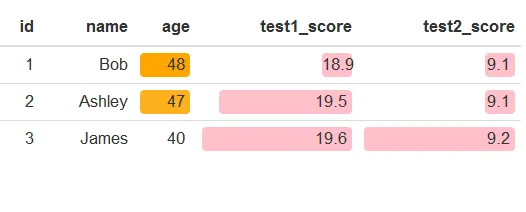样例数据(修改自formattable的github文档):
df <- data.frame(
id = 1:10,
name = c("Bob", "Ashley", "James", "David", "Jenny",
"Hans", "Leo", "John", "Emily", "Lee"),
age = c(48, 47, 40, 28, 29, 29, 27, 27, 31, 30),
test1_score = c(18.9, 19.5, 19.6, 12.9, 11.1, 7.3, 4.3, 3.9, 2.5, 1.6),
test2_score = c(9.1, 9.1, 9.2, 11.1, 13.9, 14.5, 19.2, 19.3, 19.1, 18.8),
stringsAsFactors = FALSE)
您可以像这样使用额外的颜色格式制作漂亮的表格:
library(formattable)
formattable(df, list(
age = color_tile("white", "orange"),
test1_score = color_bar("pink", 0.2),
test2_score = color_bar("pink", 0.2)
))
看起来像这样:
我想要做的是对这个表进行过滤,只保留前 n 行 - 这里 n=3。不应该采用典型的子集方式来实现,因为颜色比例尺现在仅适用于数据子集的最小/最大值,而不是原始数据。即:
formattable(df[1:3,], list(
age = color_tile("white", "orange"),
test1_score = color_bar("pink", 0.2),
test2_score = color_bar("pink", 0.2)
))
这看起来像这样:
这明显重新调整了颜色。
查看对象的 str :
str(
formattable(df, list(
age = color_tile("white", "orange"),
test1_score = color_bar("pink", 0.2),
test2_score = color_bar("pink", 0.2)
))
)
Classes ‘formattable’ and 'data.frame': 10 obs. of 5 variables:
$ id : int 1 2 3 4 5 6 7 8 9 10
$ name : chr "Bob" "Ashley" "James" "David" ...
$ age : num 48 47 40 28 29 29 27 27 31 30
$ test1_score: num 18.9 19.5 19.6 12.9 11.1 7.3 4.3 3.9 2.5 1.6
$ test2_score: num 9.1 9.1 9.2 11.1 13.9 14.5 19.2 19.3 19.1 18.8
- attr(*, "formattable")=List of 4
..$ formatter: chr "format_table"
..$ format :List of 1
.. ..$ :List of 3
.. .. ..$ age :function (x)
.. .. ..$ test1_score:function (x)
.. .. ..$ test2_score:function (x)
..$ preproc : NULL
..$ postproc : NULL
无法仅过滤/子集生成的对象,因为该结构包含其他元素。
是否有办法仅输出前n行完整的颜色比例尺,就像使用整个表格/数据框一样?


formattable中的参数,因为当您将数据子集输入到formattable时,它显然无法了解其他行。 - Carl